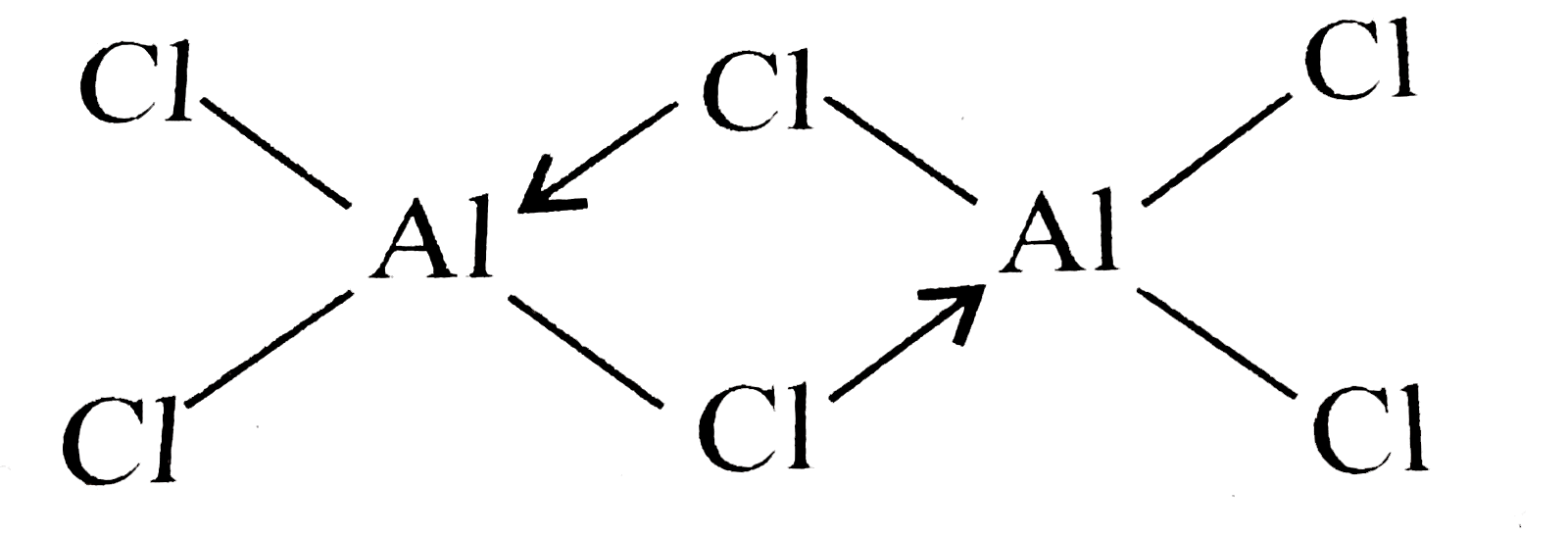An inorganic compound (X) shows the following reactions :
(a) It is white solid, exists as dimer and fumes in moist air.
(b) It sublimes at 180∘C and forms monomer on heating to 400∘C.
( c) Its aqueous solution turns blue litmus red and gives a white precipitate with AgNO3 solution which is soluble in excess of NH4OH.
(d) Addition of NaOH to the solution of (A) gives a white gelatinous precipitate which is, however, soluble on excess of NaOH.
Identify the compound (A).
(A) is Al2Cl6.
(a) Al2Cl6 is a white solid and exists as dimer.

Al2Cl6 fumes in moist air due to evolution of HCl gas.
Al2Cl6+6H2O→2Al(OH)3+6HCl↑⏐.
(b) Al2Cl6(s)180∘C−−−→Al2Cl6(g)400∘C−−−→2AlCl3
( c) Aqueous solution of Al∘Cl6 contains hydrated aluminium chloride, Al2Cl6, which is ionic in nature.
Al2Cl6+6H2O→Al2Cl6.6H2O or 2AlCl3.6H2O
AlCl3(aq)⇔Al3+(aq)+3ClӨ(aq)
Since the above solution is acidic, it turns blue litmus red.
AlCl3+3H2O→Al(OH)3Weak base+3HClStrong acid
On addition of AgNO3 solution in aqueous solution of aluminium chloride, white precipitate of AgCl is formed.
ClӨ(aq)+Ag⊕(aq)→AgCl↓(White ppt.)
AgCl is soluble in excess of NH4OH due to the formation of soluble complex, [Ag(NH3)2]Cl.
AgCl+2NH4OH→[Ag(NH3)2]Cl+2ӨOHDiamminesilver(I)chloride
(d) Aqueous solution of (A)+NaOH→Whitegelatinous ppt.↓Excess NaOHWhiteppt. dissolves
Al3++NaOH→Al(OH)3⏐↓White ppt.+Na⊕
Al(OH)3+NaOHExcess→NaAlO2Sodium metaluminate+2H2O
Due to the formation of Al(OH)3 initially, white gela-tionous precipitate is obtained, which dissolves on excess of NaOH due to the formation of sodium meta-aluminate.
Topper's Solved these Questions
- P-BLOCK GROUP 13 - BORON FAMILYBOOK - CENGAGE CHEMISTRYCHAPTER - P-BLOCK GROUP 13 - BORON FAMILYEXERCISE - Ex 6.1 (Subjective)
17 Videos
- P-BLOCK GROUP 13 - BORON FAMILYBOOK - CENGAGE CHEMISTRYCHAPTER - P-BLOCK GROUP 13 - BORON FAMILYEXERCISE - Ex 6.1 (Objective)
14 Videos
- P-BLOCK GROUP 13 - BORON FAMILYBOOK - CENGAGE CHEMISTRYCHAPTER - P-BLOCK GROUP 13 - BORON FAMILYEXERCISE - Exercise Archives (Subjecive)
9 Videos
- ORGANIC REACTION MECHANISMBOOK - CENGAGE CHEMISTRYCHAPTER - ORGANIC REACTION MECHANISMEXERCISE - Analytical and Descriptive
6 Videos
- P-BLOCK GROUP 14 - CARBON FAMILYBOOK - CENGAGE CHEMISTRYCHAPTER - P-BLOCK GROUP 14 - CARBON FAMILYEXERCISE - Exercises Archives (Subjective)
9 Videos
Similar Questions
An inorganic Lewis acid (X) shows the following reactions :
(a) It fumes in moist air.
(b) The intensity of fumes increase when a rod dippod in NH4OH is brought near it.
( c) To an aqueous solution of (X), addition of NH4Cl and NH4OH gives a precipitate which dissolves in NaOH solution.
(d) An acidic solution of (X) does not give a precipitate with H2S.
Identify (X) and gives chemical reactions for (a) to (d).
View SolutionAn aqueous solution of colourless metal sulphate M, gives a white precipitate with NH4OH.This was soluble in excess of NH4OH. On passing H2S through this solution a white precipitate is formed.The metal M in the salt is:
View Solution
Knowledge Check
Group 13 element reacts with halogen and forms a compound P shows the following properties:
(i) It is white solid and exist as dimer, gives fumes of Q with moist air
(ii) It sublimes on 1800C and forms monomer if heated to 400∘C
(iii) Its aq solution turns blue litmus to red
(iv) Addition of NH4OH and NaOH separately to a solution of P gives white precipitate which is however soluble in excess of NaOH solution to form a solution R
What is compound PAB2Cl6BN2O3C(TlCl3)2DAl2Cl6Group 13 element reacts with halogen and forms a compound P shows the following properties:
(i) It is white solid and exist as dimer, gives fumes of Q with moist air
(ii) It sublimes on 1800C and forms monomer if heated to 400∘C
(iii) Its aq solution turns blue litmus to red
(iv) Addition of NH4OH and NaOH separately to a solution of P gives white precipitate which is however soluble in excess of NaOH solution to form a solution R
Anionic formula of solution R is :A[B(OH)6]3−B[Al(OH)4(H2O)2]−C[Al(OH)6]3−D[Al(OH)5]3−On addition of aqueous NaOH to a salt solution, a white gelatinous precipitate is formed, which dissolves in excess of alkali. The salt solution contains
AChromous ionsBAluminium ionsCBarium ionsDIron ions.
On addition of aqueous NaOH to a salt solution, a white gelatinous precipitate is formed, which dissolves in excess of alkali. The salt solution contains
View SolutionAn aqueous solution of colourless metal sulphate M gives a white ppt with NH4 OH. This was soluble in excess of NH4OH, On passing HQS through this solution a white ppt is formed. The metal Min the sait is .
View SolutionA colourless solid A dissolves in water. The aqueous solution gives a white precipitate B when NaOH or NH4 OH is added. B dissolves in excess of NaOH but not in excess of NH,OH. BaCl2 solution added to a solution of A gives a white precipitate C which is insoluble in dilute HCI. A may be
View SolutionAqueous solution of a salt when treated with AgNO3 solution gives a white precipitate , white dissolves in NH4OH. Radical present in the salt is
View SolutionAn aqueous solution turns red litmus solution blue. Excess addition of which of the following solution would reverse the change?
View Solution
